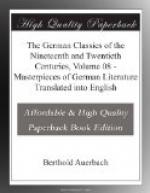The French Neo-Romanticists, who declare war in the most decided manner against all literary traditions of the eighteenth century, nevertheless absolutely revel in material furnished by that time; the gentlemen in wigs have become their most profitable heroes, and in real life, as well as in our novels, we can find no more modern way to decorate our parlors and our furniture than by covering them with the scroll work of the wig-age. This is only an apparent contradiction. It is not the Pigtail but the Rococo that we are reviving so industriously, not the academic constraint of rules, but the subjective arbitrariness, the spirit of the original, freakish types. This untrammeled caprice of the Rococo age seems to us as fresh as nature compared with the well planned symmetry of our modern conditions, which no longer permit one to be a real fool, and therefore do not allow any dazzling figures of romance to come to the surface, just as the eighteenth century, on its part, no longer engendered any real dramatic characters. If Rousseau, as soon as the spirit of coarseness came over him, hurls the most spirited abuse at everybody, if the peasant poet, Robert Burns, “a giant original man,” as Thomas Carlyle calls him, suddenly appearing among the puppets and buffoons of the eighteenth century, is gaped at like a curiosity in the salons of Edinburgh on account of his rough simple nature, then we too can find delight in the natural strength which is hidden in the Pigtail under the form of the Rococo. Even the historian of art, who grows indignant over the extinction of the historic sense in that age, over the vandalism with which an arrogant lack of understanding destroyed the monuments of the Middle Ages—even he must, at the same time, admire the self consciousness which speaks in this vandalism, the defiant belief in the wisdom of their own age, which boldly remolded everything to suit their own taste because they were finally persuaded that this taste was the only true one. It is a peculiar sign of conscious strength and of vitality breaking out in the midst of the sickly life of a degenerate age. We can almost envy the old pigtails for this blind belief in themselves, which grows out of the boastful arbitrariness of the Rococo, in the midst of and in spite of the constraint of the Pigtail, and is closely connected with the mad cult of originality practised by so many individual types. We have strong doubts concerning the excellence of our advanced mental development, while in the days of our great-grandfathers nobody doubted that that age, which we properly stigmatize with the sobriquet of the Pigtail Age, was really the golden age of art and science.




